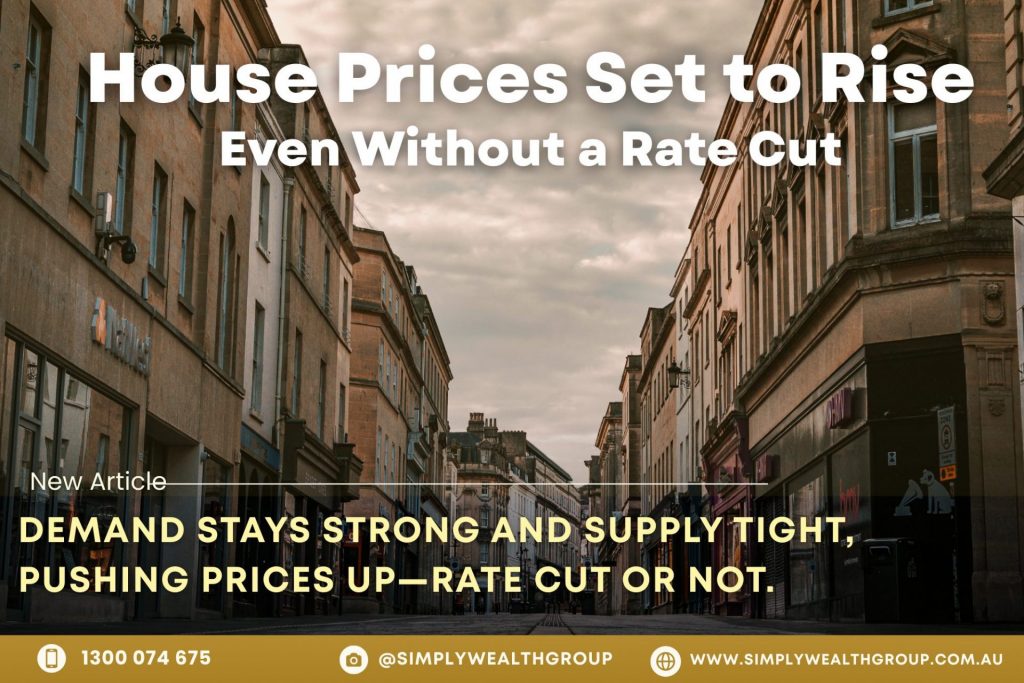House Prices Set to Rise, Even Without a Rate Cut
Australia’s property market is defying expectations. Even as the Reserve Bank of Australia (RBA) pauses on further interest rate cuts, house prices continue their upward march. This phenomenon is not just a quirk of the current economic cycle—it’s the result of deep, persistent forces shaping the housing landscape. In this comprehensive article, we explore why property prices are rising, the key drivers behind this trend, and what it means for buyers, sellers, investors, and policymakers in 2025 and beyond.
The Current State of Australia’s Housing Market
Recent Trends and Data
- National Growth: Property prices rose 4.6% nationally in the 12 months leading up to June 2025, according to PropTrack data. Five capital cities—Sydney, Melbourne, Brisbane, Canberra, and Adelaide—now have median home values exceeding $1 million. Momentum Continues: Despite the RBA’s decision to hold the official cash rate at 3.85% in July 2025, housing prices have not stalled. Instead, the market remains buoyant, with strong auction clearance rates and persistent buyer demand.
- Forecasts: Major banks and property analysts predict continued growth. Domain’s Property Price Forecast Report expects average house prices to increase by 4-6% nationally in 2025, with some variation across states and cities.
Why Are House Prices Rising Without a Rate Cut?
- Chronic Housing Shortage
- Supply vs. Demand: Australia is not building enough homes to keep up with its rapidly growing population. In 2024, only 163,760 new dwellings were approved, far below the government’s annual target of 240,000.
- Construction Challenges: Labor shortages, high material costs, and planning bottlenecks have slowed the construction pipeline. This persistent undersupply is putting upward pressure on both house prices and rents.
- Strong Population Growth
- Migration Surge: Australia’s population growth, fueled by immigration, is intensifying demand for housing, especially in major cities. This is happening at a time when new supply is lagging, creating a perfect storm for price increases.
- Investor Confidence and Market Sentiment
- Investor Activity: Low rental vacancy rates and rising rents are attracting investors back into the market. Many see property as a hedge against inflation and a source of stable returns.
- FOMO (Fear of Missing Out): As property values rise and media reports highlight new record prices, more buyers are rushing to enter the market before prices climb even higher.
- Anticipation of Future Rate Cuts
- Market Expectations: Both the Commonwealth Bank (CBA) and ANZ forecast two more rate cuts in 2025—one in August and another in November. The prospect of lower rates is already influencing buyer behavior, as many expect borrowing costs to fall soon.
- Timing, Not Direction: RBA Governor Michele Bullock emphasized that the July pause was a matter of timing, not a change in the overall direction of monetary policy. This has reassured the market that rates will eventually move lower, supporting ongoing price growth.
- Government Policies and Incentives
- First-Home Buyer Schemes: Various state and federal initiatives are helping first-home buyers enter the market, albeit with mixed results in the face of rising prices.
- Planning Reforms: Some states, like NSW, are increasing housing density and fast-tracking approvals to boost supply, but these measures are yet to fully offset the supply deficit.
The Role of Interest Rates: Myth vs. Reality
Historical Relationship
- Conventional Wisdom: Traditionally, falling interest rates boost property prices by increasing borrowing power and demand. Conversely, rising rates tend to cool the market.
- Current Cycle: While recent rate cuts in February and May 2025 did stimulate price growth, the July pause has not led to a reversal. Instead, prices are still climbing, albeit at a potentially slower pace until the next anticipated cut.
Why Prices Can Rise Even Without a Cut
- Structural Factors Dominate: The chronic housing shortage, strong population growth, and robust investor demand are now the primary forces driving prices higher. Even without immediate rate cuts, these factors are more than compensating for the temporary pause in monetary easing.
- Short-Term vs. Long-Term: The gap between July and the next expected rate cut is only a matter of weeks. Most experts agree this will not significantly impact the overall upward trajectory of house prices.
Regional and City-by-City Breakdown
| City/Region | 2025 Price Growth Forecast | Key Drivers |
| Sydney | 4-6%[3] | Low supply, strong demand, micro-markets emerging |
| Melbourne | 3-5%[3][6] | Investor return, affordability challenges |
| Brisbane | 6-8%[2] | Population growth, interstate migration |
| Perth | 7-9%[2] | Supply shortage, mining sector strength |
| Adelaide | 5-7%[3] | Tight rental market, limited new supply |
| Canberra | 4-6%[3] | Government employment stability |
Note: These are indicative forecasts, and actual outcomes may vary.
Winners and Losers: Who Benefits from Rising Prices?
Existing Homeowners
- Equity Gains: Rising prices benefit current homeowners, allowing them to leverage increased equity for upgrades or investment properties.
- Wealth Effect: Higher property values can boost consumer confidence and spending.
First-Home Buyers
- Barriers to Entry: For newcomers, rising prices make it harder to get on the property ladder. Even with government incentives, affordability remains a major hurdle, especially in capital cities.
- Shift to Units and Outer Suburbs: Many first-home buyers are opting for apartments or relocating to more affordable regions.
Investors
- Rental Yields: Tight rental markets and rising rents are making property investment attractive again, particularly in cities like Brisbane and Perth.
- Portfolio Expansion: Existing investors can use their growing equity to acquire additional properties, further fueling demand.
Risks and Headwinds
Affordability Crisis
- Stretched Budgets: As prices rise, more households are being priced out of the market or forced to take on larger mortgages.
- Social Impacts: The affordability crisis is contributing to rising inequality and housing insecurity, especially among younger Australians and low-income earners.
Economic Uncertainty
- Recession Fears: Geopolitical tensions and concerns about a potential recession could dampen consumer confidence and slow the market, though these risks have not materialized so far.
- Job Security: Worries about employment prospects may cause some buyers to delay major financial decisions.
Policy and Regulatory Changes
- APRA Buffer: The Australian Prudential Regulation Authority’s (APRA) 3% mortgage serviceability buffer may be relaxed if rates fall, potentially increasing borrowing capacity but also risk.
- Tax and Planning Reforms: Ongoing debates about negative gearing, stamp duty, and planning regulations could reshape the market landscape in the coming years
What’s Next? Outlook for the Remainder of 2025 and Beyond
Short-Term (Next 6-12 Months)
- Continued Growth: Most analysts expect house prices to keep rising through the rest of 2025, with the pace of growth potentially accelerating after the next round of rate cuts.
- Supply Constraints: The shortage of new housing is unlikely to be resolved quickly, maintaining upward pressure on prices.
Medium-Term (2026-2028)
- Population and Supply: Unless Australia dramatically increases housing construction, the imbalance between supply and demand will persist, supporting further price growth[.
- Interest Rate Path: The RBA is expected to continue a gradual easing cycle, which will likely provide additional support for the property market
Practical Advice for Buyers, Sellers, and Investors
For Buyers
- Act Sooner Rather Than Later: With prices projected to rise further, delaying a purchase could mean paying more down the track.
- Consider Alternatives: Look at units, townhouses, or outer suburbs for better value and affordability.
- Get Pre-Approved: In a competitive market, having finance in place gives you a crucial edge.
For Sellers
- Strong Negotiation Position: Low supply and high demand mean sellers can often achieve premium prices.
- Timing Matters: Listing in spring or ahead of anticipated rate cuts could maximize your sale price.
For Investors
- Focus on Yield: Target areas with tight rental markets and strong population growth for the best returns.
- Leverage Equity: Rising property values can be used to expand your portfolio, but be mindful of borrowing risks.
Frequently Asked Questions
Will house prices fall if the RBA delays further rate cuts?
Most experts believe prices will continue to rise, even if rate cuts are delayed, due to the underlying supply-demand imbalance and strong market sentiment.
Which cities are likely to see the strongest growth?
Brisbane and Perth are tipped to outperform, thanks to rapid population growth and acute housing shortages. Sydney and Melbourne will also see gains, but affordability constraints may temper growth.
Is now a good time to buy property in Australia?
While every buyer’s situation is unique, the general consensus is that waiting may only mean paying more later, especially if supply remains tight and rates eventually fall.
Conclusion
Australia’s property market is in the midst of a unique cycle. Even as the RBA hits pause on further rate cuts, house prices are set to rise, driven by chronic undersupply, strong population growth, robust investor demand, and the expectation of future monetary easing. For buyers, sellers, and investors, understanding these forces is crucial to making informed decisions in a rapidly evolving market.
The road ahead will not be without challenges—affordability, economic uncertainty, and policy changes are all potential headwinds. But for now, the upward trend looks set to continue, making 2025 another pivotal year in Australia’s real estate story.
This article is an original, educational overview based on the latest market data and expert commentary as of July 2025. For more details, see the linked coverage at Australian Broker and other cited sources.
- https://www.brokernews.com.au/news/breaking-news/house-prices-set-to-rise-even-without-a-rate-cut-287538.aspx
- https://propertyupdate.com.au/australian-property-market-predictions/
- https://www.auspropertyprofessionals.com.au/2025/04/28/australian-property-market-forecast-for-2025/
- https://futurerent.com.au/blog/market-update-july-2025-growth-cycle-accelerates
- https://www.mortgagechoice.com.au/news/shock-likelihood-of-interest-rate-cut-path-for-2025/
- https://australianpropertyupdate.com.au/apu/melbourne-home-prices-leap-on-the-back-of-interest-rate-cuts








